Pratikraman Ek Rahasyamai Yog Sadhna
Added to library: September 2, 2025

Summary
This is a comprehensive summary of the Jain text "Pratikraman Ek Rahasyamai Yog Sadhna" based on the provided pages:
Book Title: Pratikraman Ek Rahasyamai Yog Sadhna (प्रतिक्रमण एक रहस्यमयी योग साधना) Author: Dr. Sadhvi Saumyaguna Shri (Dr. साध्वी सौम्यगुणा श्री) Publisher: Prachya Vidyapith, Shajapur Catalog Link: https://jainqq.org/explore/006249/1
This text is a voluminous doctoral research thesis (D.Litt.) focusing on "A Comparative and Critical Study of Jain Rituals and Practices," specifically Volume 12, which deals with the profound practice of Pratikraman.
Core Theme: The book delves into Pratikraman (प्रतिक्रमण), presenting it as a profound and mystical yogic discipline within Jainism. It aims to explore the rituals, their underlying philosophy, and their practical application for spiritual purification and liberation.
Key Aspects Covered:
-
The Nature of Pratikraman:
- Definition and Meaning: The text defines Pratikraman as a return to one's true nature, a process of self-purification, and a tool for shedding faults and overcoming spiritual lapses. It emphasizes that it's not just about regretting past mistakes but also about resolving not to repeat them.
- Etymology and Synonyms: It discusses the word Pratikraman and its derivation, explaining its meaning as 'returning' or 'stepping back' from negative actions. It also lists eight synonyms for Pratikraman found in Jain scriptures, highlighting its multifaceted nature: Pratikraman, Praticharan, Praticharan, Varana, Nivritti, Ninda, Garda, and Shuddhi.
- Importance in Jainism: Pratikraman is identified as the fourth of the six essential daily duties (Shadaavashyak), considered crucial for self-improvement and spiritual progress. It's described as a vital means for self-reflection, confession of faults, and purification of the soul.
-
The "Mystical Yoga" Aspect:
- The title itself suggests that Pratikraman is more than a mere ritual; it's a form of yoga, a spiritual practice aimed at uniting the soul with liberation (Moksha).
- It's presented as a "mysterious yoga sadhana" (Rahasyamai Yog Sadhna), implying that its deeper meanings and benefits are revealed through dedicated practice and study.
-
Historical and Scriptural Context:
- The text traces the origins and evolution of Pratikraman practices through various Jain scriptures like Aavashyak Sutra, Uttaradhyayan Sutra, Panchavastuk, and Sadhu Vidhi Prakash.
- It highlights that while initially Pratikraman was performed only upon committing an offense, Lord Mahavir made it a compulsory daily practice (ubhay sandhyaon) for all aspirants due to the influence of the Dusham Kaal (the current degenerating era).
-
Comparative Study:
- A significant portion of the research involves comparing Jain Pratikraman with similar practices in other religious traditions like Buddhism, Vedic traditions (Sandhya Karma), Christianity (Confession), and Islam. This comparative analysis aims to show the universal appeal of self-purification and confession across different faiths.
- The text acknowledges that while the term Pratikraman might not be used in Buddhism, concepts like Pratikarma, Pravarana, and Paap Deshna serve a similar purpose.
-
Detailed Analysis of Pratikraman Rituals:
- The book elaborates on the specific procedures and nuances of Pratikraman across different Jain sects and traditions (e.g., Kharatargachh, Tapagachh, Achalgachh, etc.).
- It discusses the various types of Pratikraman performed daily (Daivasik), fortnightly (Paakshik), quarterly (Chaturmasik), and annually (Samvatsarik).
- It explains the "why" and "how" of each ritual, including the specific verses (sutras) used, the meaning behind them, the historical context, and even the intended postures (mudras) and their effects.
- The text addresses the importance of internal disposition (Bhav) versus external ritual (Dravya) in Pratikraman.
-
Resolving Doubts and Misconceptions:
- The research aims to clarify common misconceptions about Pratikraman, such as whether saying 'Michchhami Dukdam' (मिच्छामि दुक्कडं) alone is sufficient for atonement or if it's merely a ritualistic tradition. It emphasizes the underlying sincerity and commitment to change.
- It addresses the practical challenges faced by householders in performing these practices and offers insights into their relevance in modern life.
-
The Role of Key Figures:
- The book acknowledges and expresses gratitude to numerous spiritual guides and scholars, including Pujya Pravartini Shri Sajjan Shri Ji M.S.A., Param Vidushi Shashi Prabha Shri Ji M.S.A., Acharya Shri Majjin Kailash Sagar Surishwarji M.S.A., Upadhyay Pravar Shri Maniprabh Sagarji M.S.A., and Dr. Sagarmal Jain, who guided and inspired this extensive research.
- It particularly highlights the dedication and arduous journey of Sadhvi Saumyaguna Shri herself, overcoming numerous obstacles over 17 years to complete this massive 23-volume work.
-
Structure and Content Breakdown (from Table of Contents):
- Chapter 1: Analysis of the Nature of Pratikraman: Covers the meaning, definitions, synonyms, and types of Pratikraman.
- Chapter 2: Multi-faceted Research into the Profound Secrets of Pratikraman: Explores the reasons for its necessity, who should perform it, when, the causes of offenses (atichara), the importance of daily practice, the significance of Pratikraman within the Shadaavashyak, the creators of Pratikraman texts, its four stages, spiritual aspects, and its relevance in various contexts.
- Chapter 3: When and How to Use Pratikraman Sutras: Discusses the scriptural names of Pratikraman sutras, their usage with mudras, their connection to the six aavashyakas, and the antiquity of these sutras.
- Chapter 4: Fundamental Methods of Pratikraman and Comparative Review: Details the specific rituals for night (Rātrik), daily (Daivasik), fortnightly (Paakshik), quarterly (Chāturmasik), and annual (Samvatsarik) Pratikraman across different Jain traditions, along with comparative analyses with Buddhist, Vedic, and other traditions.
- Chapter 5: Purposes and Solutions to Doubts regarding Pratikraman Methods: Addresses the reasons behind specific Pratikraman rituals, clarifies common queries, and explains the rationale for certain practices.
- Chapter 6: Precautions and Exceptional Procedures in Pratikraman Practice: Focuses on essential rules, precautions, and special circumstances during Pratikraman.
- Chapter 7: Conclusion: Summarizes the significance of Pratikraman as a path to spiritual purification, self-discovery, and the resolution of life's challenges.
In essence, "Pratikraman Ek Rahasyamai Yog Sadhna" is a monumental scholarly work that meticulously dissects the Jain practice of Pratikraman, highlighting its yogic, spiritual, historical, and comparative dimensions. It serves as an in-depth guide for understanding and practicing this vital aspect of Jain spiritual discipline.